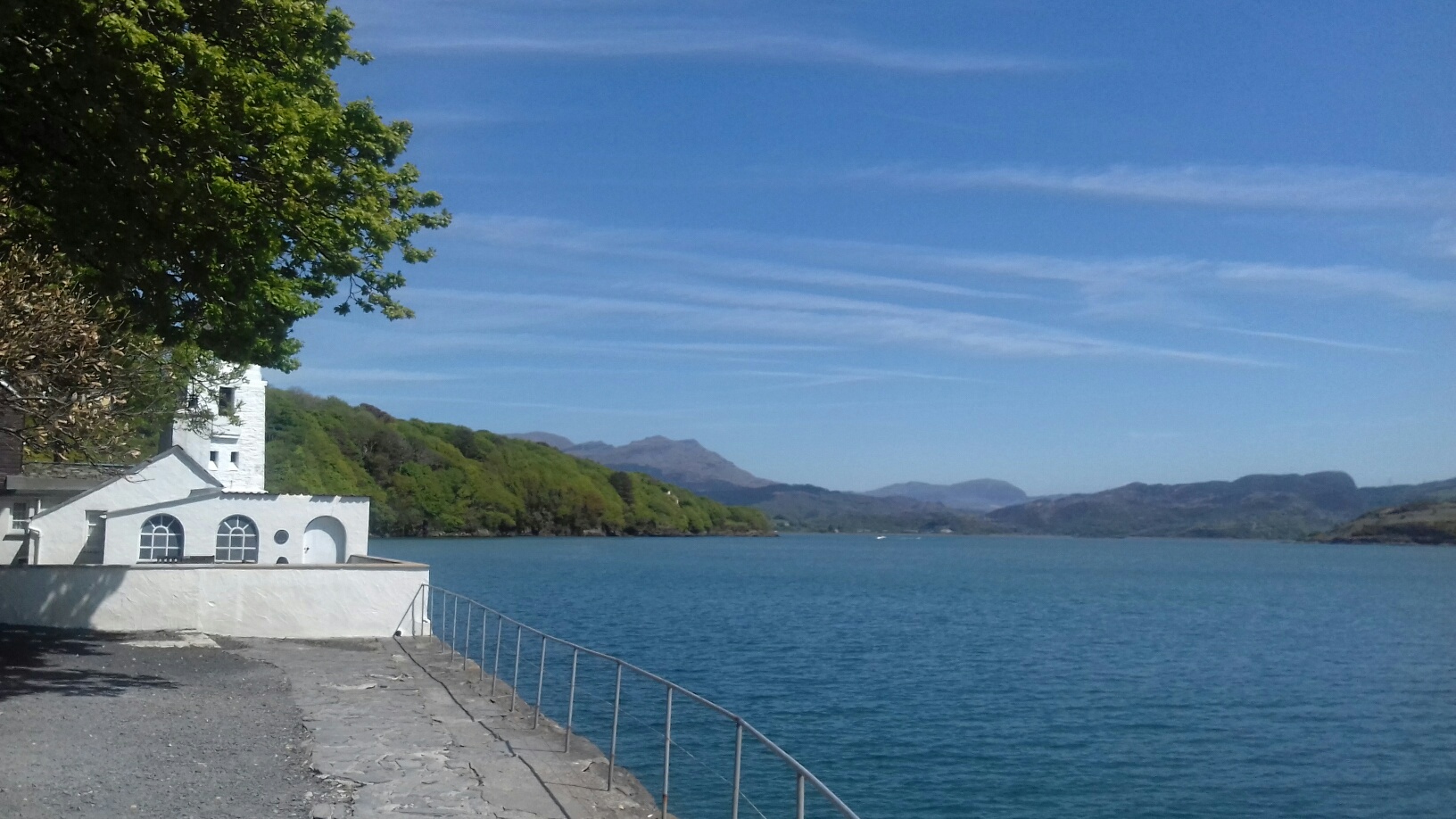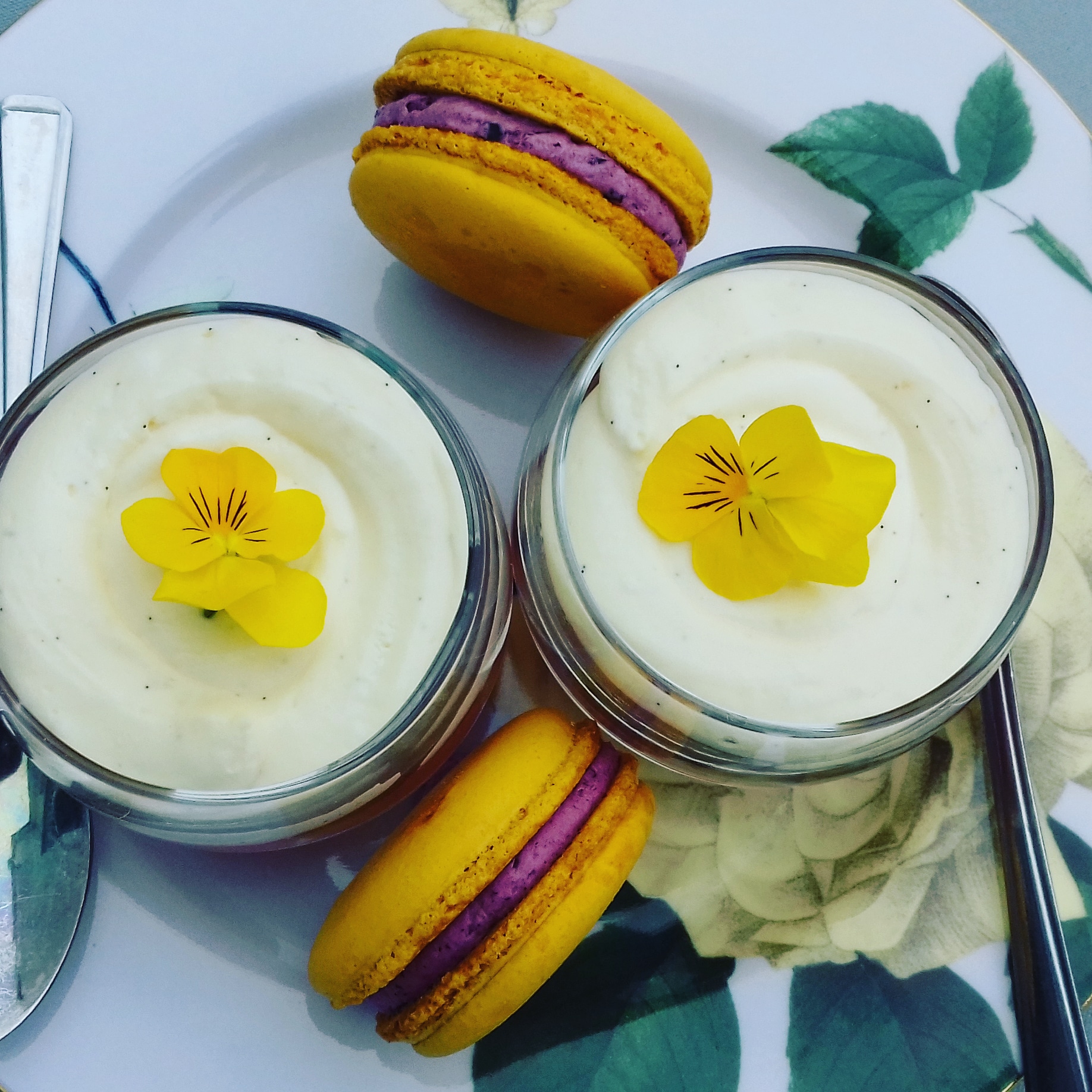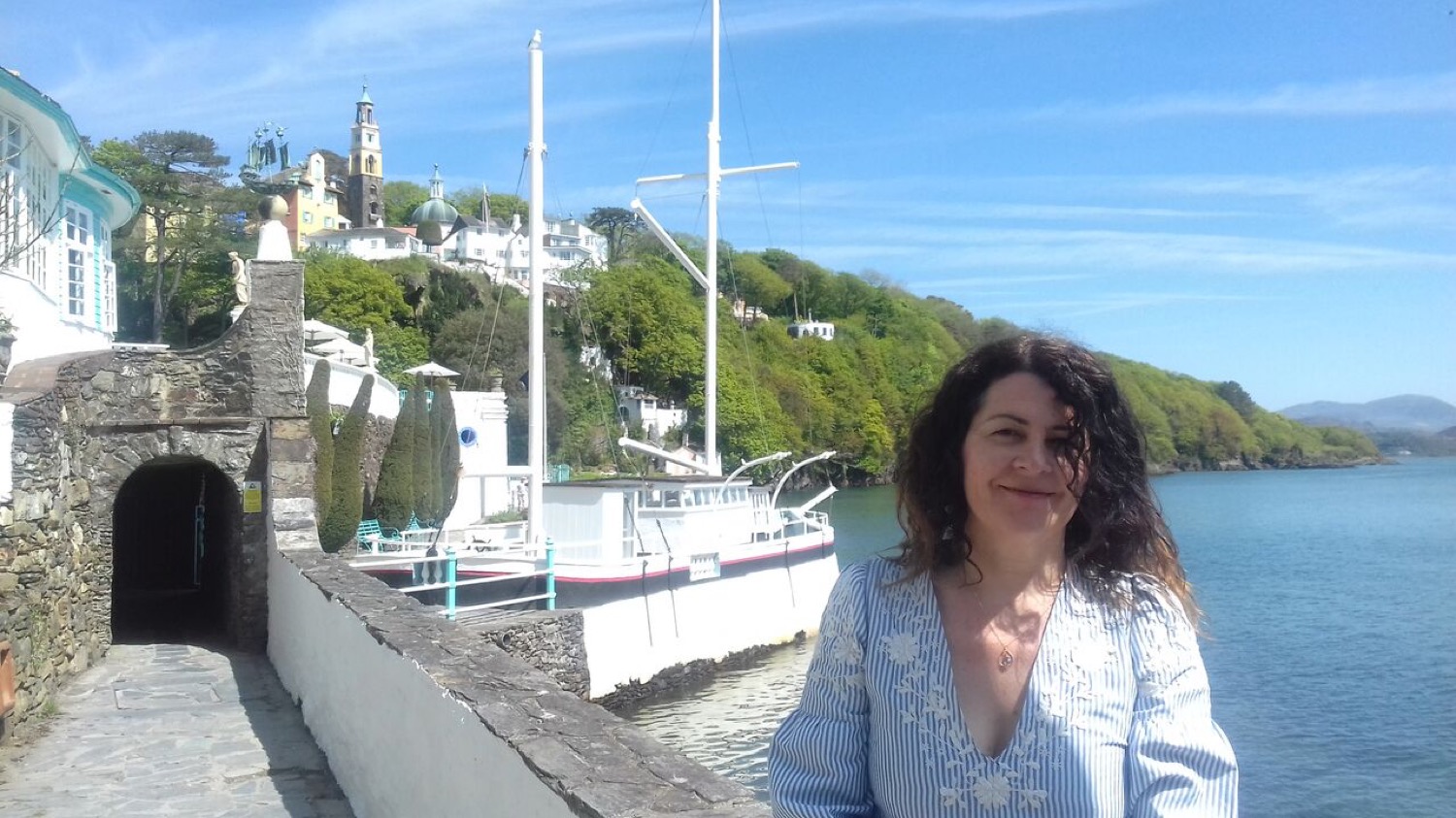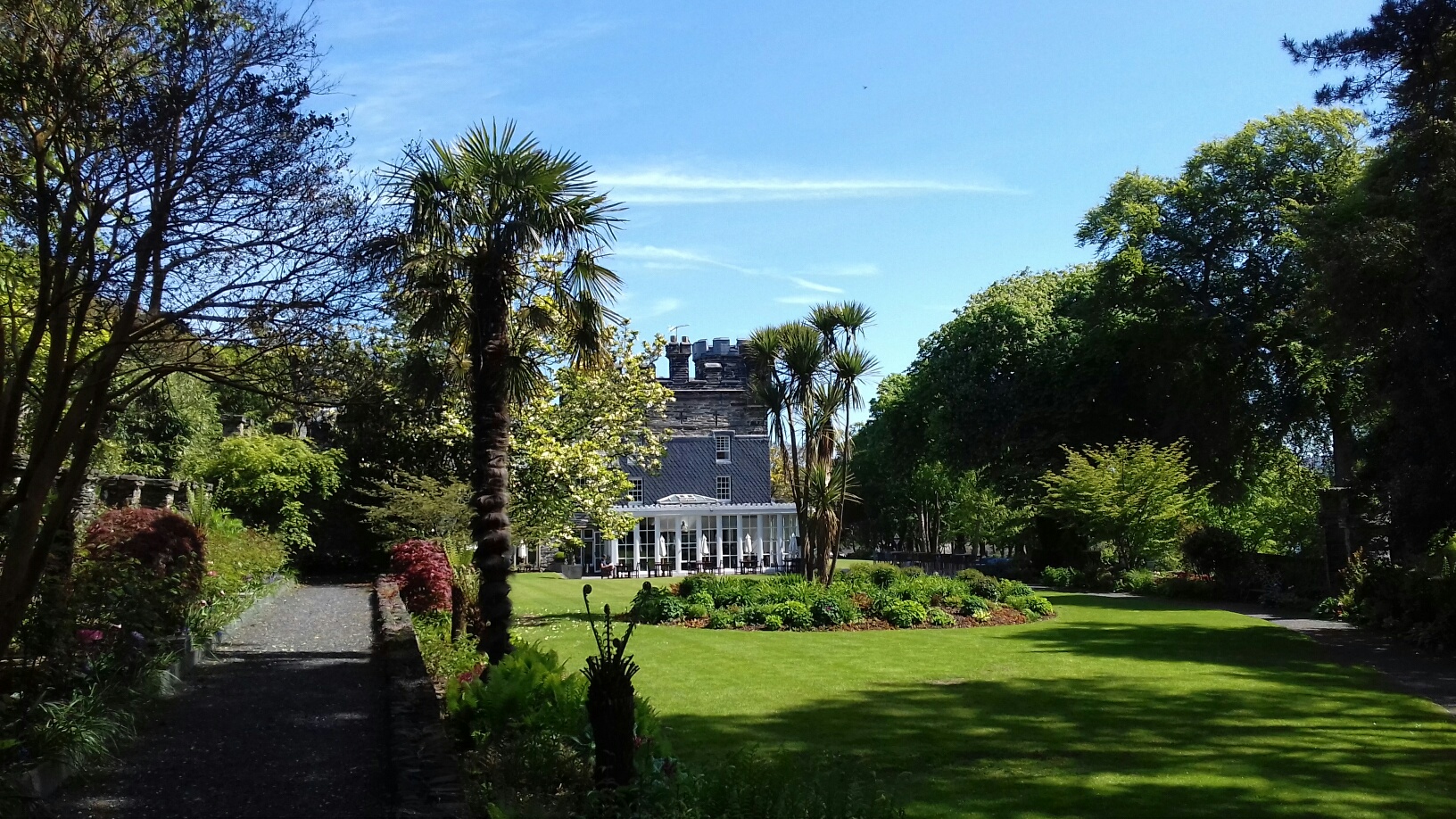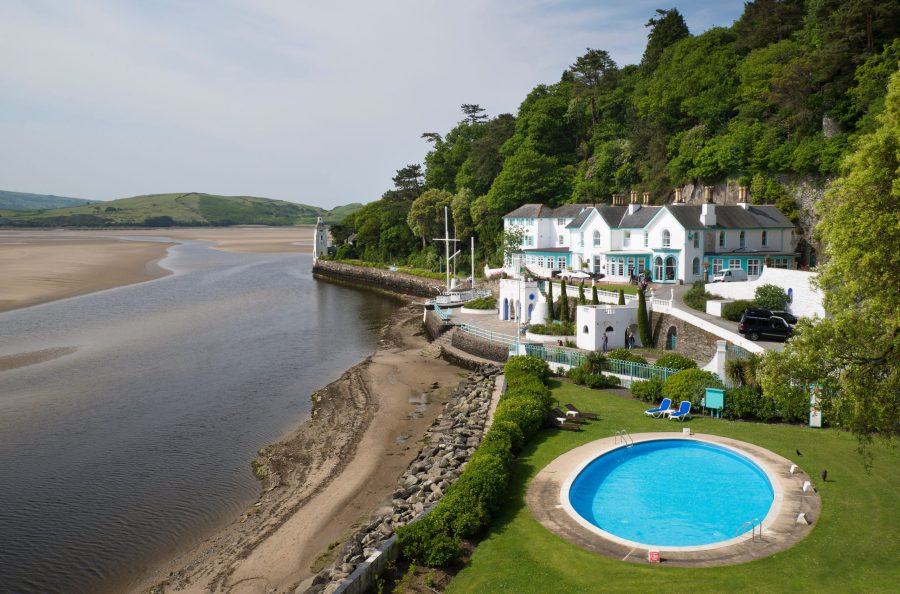coast editor Alex Fisher is dazzled by this unique holiday village in North Wales, which has been the haunt of artists and celebrities ranging from Noël Coward and Bertrand Russell to Brian Epstein and Jools Holland
A bell tower reminiscent of traditional Italian architecture rises through the trees, next to this a domed building with an ornate, gothic-style porch sits in front of primrose, aqua and pink cottages. Cherubs can be seen in rock faces, a huge golden Buddha inhabits its own mini-temple and as you walk into the central piazza you’re greeted by an 18th century colonnade overlooking a giant chess set. Around the corner, the Town Hall is more Arts and Crafts style and below, a wrecked sailing ship has been built into the sea wall. You would think the mixture of Italian, Georgian and Arts and Crafts architecture, the amalgamation of genuinely historic buildings (the colonnade) with cast-offs from film sets (Buddha), would make a confused jumble, but actually the overall impact of Portmeirion is stunningly beautiful.
‘Cherish the past, adorn the present, construct for the future,’ was the motto of Clough Williams-Ellis, the creator of this extraordinary, whimsical tourist village. Clough spent his life transforming a near-derelict estate on the estuary of the River Dwyryd into the colourful resort it remains today, which now attracts nearly a quarter of a million visitors each year. Having studied architecture for just three months, he reputedly left college as he believed that creating buildings should be more fun. He conceived the idea of a small village that would illustrate his vision, and finally found his ideal site just six miles from his family home in Wales. Originally called Aber Iâ (glacial estuary), Clough changed the name of the location to Portmeirion (Merioneth being the Welsh name of the county at the time) after he purchased the site with a loan of £5,000 in 1925.
Clough first transformed the existing house into a hotel to bring in an income to fund his vision, then added to the village every year, incorporating historically significant salvaged architecture and artworks that otherwise would have been destroyed into the buildings: the Town Hall houses a Jacobean plaster ceiling he bought for £13 and the Bell Tower used stones from the 12th-century castle, whose ruins remain in the nearby woods, having sadly been demolished in the19th century. Building halted during WWII but resumed when hostilities ceased, and after the cult TV series The Prisoner was filmed here in the 1960s the number of visitors increased tenfold. Clough continued to add new buildings to his village until 1976, when he was 93. He passed away just two years later, having completed the vision he’d had since childhood.
Friday 7pm
CASTLE STAY
It’s a long, but beautiful, drive to the coast of Gwynedd from the south east of England, made even lengthier because I keep stopping to take photos of the stunning valleys I’m travelling through. When I arrive at the sweeping entrance to Castell Deudraeth just outside Portmeirion, I’m equally impressed. Although not a ‘real’ castle, having been converted into a castellated structure in the 1850s, it has a strong presence and sits proudly in Victorian gardens. The property was purchased by Clough in 1931, but it wasn’t until 1999 that the charity which now runs Portmeirion Village restored the building with the help of the Lottery, European and Welsh Tourist Board funding.
After a warm welcome I get changed in my large, modern bedroom and head downstairs for supper. In elegant surroundings overlooking the grounds I enjoy a meal of scallops and chorizo, followed by a roasted fillet of hake in the brasserie-style restaurant. Starters begin at £6.50 and mains around £12.50. You can also have a two-course lunch here for around £20 a head, which includes free entry to the village (01766 770000,
portmeirion-village.com/stay/castell-deudraeth/).
Saturday 10am
A GUIDED TOUR
The sun is shining and the sky is bright blue as I enter Portmeirion, and I am dazzled by the view. Through an archway I can see the sea sparkling between elegant Cypress trees and it feels more like Italy than Wales. Free guided tours run throughout the day from late March to late October, but I’m being shown around by Meurig Jones, the long-standing locations manager who clearly has an extensive knowledge and a deep passion for the village. He points out some of the quirks one could easily miss: the windows painted on to make some houses appear bigger, others smaller, The Beatles manager Brian Epstein’s holiday home of six years and the apartment where Noël Coward wrote his play, Blithe Spirit. The more stories I hear, the more extraordinary Portmeirion becomes (01766 770000,
portmeirion-village.com).
Saturday 12pm
TRAIN RIDE
As well as the 50 odd buildings that make up the village, there are 70 acres of sub-tropical woodlands for visitors to explore. The mild climate nurtures many rare species of plant, and the 20 miles of paths through the woodland to the surrounding beaches offer beautiful sites and vistas. In the 1960s Clough marked out where he wanted lakes to be created and his daughter, Susan Williams-Ellis, oversaw the landscaping. She also designed a Japanese-style bridge and pagoda to sit over the largest lake, and a Classical temple above the aptly named Temple Pond. I hop on the free land train, which runs from Salutation Square in high season, for a 20-minute tour and marvel at the towering rhododendrons and colourful camellias.
Saturday 1pm
LAZY LUNCH
There are plenty of cafés and restaurants in the village, but on a sunny day I’m keen to sit outside. I find a table in Caffi Glas, opposite where the train stops, and order a cold glass of Portmeirion’s own Pinot Grigio. The relaxed, Italian restaurant offers pizzas, pastas, steaks and fish dishes, and I opt for lobster ravioli with a Menai mussel seafood sauce at a reasonable £12.50. The café also serves paninis, gluten-free pasta and salads. After lunch I stroll down to Caffi’r Angels Ices just across the road, for a homemade ice cream cone. Made on-site daily, there’s a wide range of flavours, including malt barley and raspberry pavlova.
Saturday 4pm
TIME TO RELAX
A recent addition to the village is The Mermaid Spa. Tucked away from the main piazza and overlooking the estuary, it’s a quiet place to relax and soak up the view. After a cup of jasmine tea I enjoy a head and shoulder massage that gets rid of the stress and tension from my long drive here. The spa offers everything from full body massages, salt scrubs, seaweed wraps and manicures. Open every day, 9am-6pm during the week and until 5pm at weekends (01766 772444).
Saturday 5pm
A WATERSIDE HOTEL
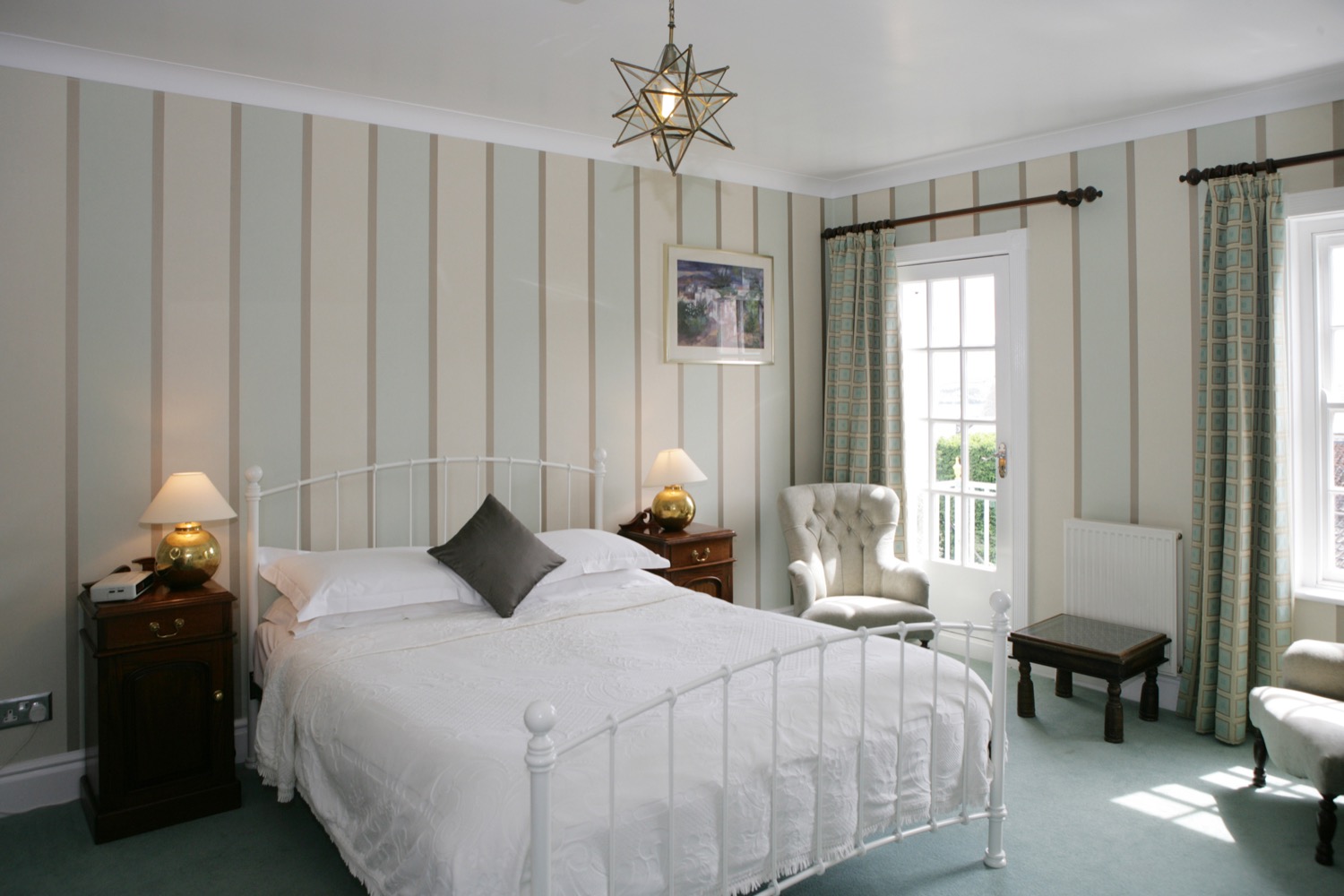
I float out of the spa and the sound of running water beckons me between the elegant colonnades and purpose-built sunken tile roofs. A waterfall bubbles down towards the sea, where Hotel Portmeirion sits at the water’s edge. This Grade II-listed building was the original mansion on the Aber Iâ estate, built in 1850. When Clough purchased the property it was virtually derelict and he renovated and extended it, and added the curved front sections on the ground floor, which make more of the stunning sea views. The hotel has a magnificent Italian Renaissance fireplace and a library recycled from the Great Exhibition of 1851. The bedrooms here are slightly more traditional than those at Castell Deudraeth, and benefit from uninterrupted views of the estuary. I’ll be spending the night here, and dining at the hotel restaurant.
Saturday 7pm
FINE DINING
The 2 AA-Rosette hotel restaurant has an excellent reputation, so I opt for the introductory tasting menu (£50 per head), as I know that it will showcase the food of award-winning head chef Mark Threadgill. The dining room, by Sir Terence Conran, has been designed to have the feel of an ocean liner, and the wooden columns that punctuate the space were reputedly the masts of Clough’s sailing boat, Amis Reunis, the remainder of which is now built into the sea wall just outside the hotel. I browse the menu in the stunning Mirror Room, where we are offered beautifully presented appetisers including an incredible avocado tuile, illustrating both masterful culinary skills and an expert palate. Once in the dining room, a stream of delicious dishes arrive at the table; this is clearly the best restaurant in Portmeirion, but it’s also one of the best in Wales too.
Sunday 10am
PORTMEIRION POTTERY
After a delicious breakfast overlooking the sea at the hotel, I head into the village to explore some more of the attractions. I watch the 20-minute audio-visual show documenting the story of Portmeirion, told by Clough Williams-Ellis himself, and visit the shop dedicated to the TV series The Prisoner, where you can buy replicas of the infamous, huge, white balloons that chased star Patrick McGoohan across the beach.
I then head to the Portmeirion Pottery Shop and browse the now world-famous designs from Clough’s daughter, Susan Williams-Ellis. Susan started the ceramic range with her husband, Euan Cooper-Willis, in the 1960s, and although it was originally intended just to be sold in Portmeirion Village, the pottery soon became a global success. Many of her early designs are now hugely collectable and considered to be iconic of their time (
portmeirion.co.uk).
Sunday 3pm
COASTAL CREAM TEA
I skip lunch and save space for afternoon tea at Hotel Portmeirion. The sun is shining and I find a table outside, overlooking the Amis Reunis. When the ship was swept from its moorings in a storm, Clough salvaged the wreck and built it into the sea wall, creating a whimsical folly which gives the appearance of a ship waiting to set sail, despite the fact it is now full of concrete. The cream tea arrives as a tower of pretty cakes, scones and finger sandwiches, decorated with flowers. Golden macarons sit between rhubarb possets and delicate slices of raspberry and chocolate tart. Two pots of tea later, it’s time to head to the apartment where I will spend my final night in Portmeirion.
Sunday 5pm
THE ROYAL DOLPHIN
Nearly all of the buildings in the village are holiday accommodation. Some are self-catering and can sleep up to 10 people, whereas others are suites serviced by Hotel Portmeirion. Tonight I’m staying in Royal Dolphin, one of the serviced suites, which has a little balcony with a beautiful view of the estuary. It’s in a Grade II-listed building called The Dolphin, completed in 1934. All of the suites are decorated in a different style and mine has a delightful modern take on 1950s styling, with mid-century furniture and fantastic boldly patterned wallpaper. I love it!
As the sun begins to set, I take an evening stroll out into Y Gwyllt (The Wild Place), which is the name that Clough gave to the forest adjoining the village. Exotic planting began here in the 1850s and Clough acquired the woods in 1941. Pretty paths criss-cross around lakes, tall rhododendrons, pines, hollies and monkey puzzle trees, to a lookout point, where I sit and gaze out to sea, marvelling at the amazing legacy that Clough Williams-Ellis has left behind for so many people to enjoy.
NEED TO KNOW
STAY AT…
coast stayed at Castell Deudraeth and Hotel Portmeirion. Double rooms range from £124-£334 and were booked through Welsh Rarebits, which offers the best range of luxury, boutique and spa hotels across Wales. To book, call 0800 1032660 or visit rarebits.co.uk/gwesty-portmeirion-hotel. For more details, call Welsh Rarebits on 01570 470785.
You can visit the village for a day fee of £12. Tickets for children aged 5-15 are £8.50, under-5s free. Call 01766 770000 or see portmeirion-village.com for more information.
HOW TO GET THERE
If you’re travelling by car use the postcode LL48 6ET for sat-nav. If you’re travelling by train the nearest station is Blaenau Ffestiniog on the Conwy Valley line. If you are staying in Portmeirion village, the hotel will arrange a taxi to collect you.
Discover more about Wales at visitwales.com
